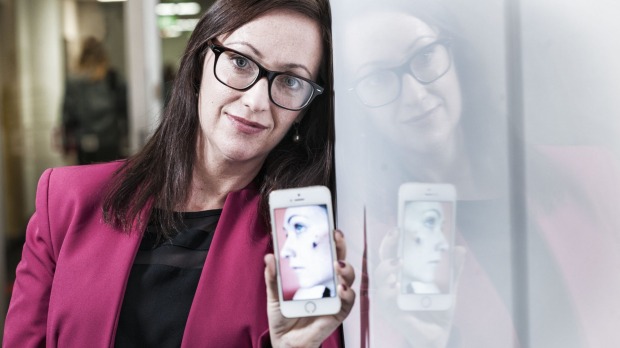
PhD researcher Kara Burns is looking at medical selfies, tracking and documenting their health and how it is changing the doctor/patient relationship. Photo: Erika Fish
The rise of the “medical selfie” could change the doctor-patient relationship forever, a Brisbane scientific photographer says.
Kara Burns is completing her PhD on “patient-generated health data”, which allows people to track and collect data on their own health by using wearable technology, smartphone apps and photography.
“To begin with I was interested in what happened when doctors took photos with patients,” the QUT student said.
“But as people became more familiar with smartphones, patients were bringing images into the consultation as well … it puts them in a more empowered position.”
A trained medical photographer who spent more than seven years in a tertiary hospital, Ms Burns is looking for patients with a condition that could benefit from medical selfies to take part in a study.
“It’s essentially a photograph of a visible pathology or visible abnormality, something like a wound, a rash, skin conditions, even a mole somebody’s worried about,” she said.
“I’m interested in what happens when a patient collects this data and takes it to their health professional and say they’ve been tracking it and ask if it’s significant to their condition,” she said.
She was also looking for carers who might find medical selfies useful with their patients, as well as doctors who treat those types of conditions, to take part in the first stage of her research.
“The first study will be about the underlying value of the data and what it means to a patient to create it,” she said.
“The second study of the PhD will be actually tracking symptoms … that will be early next year.”
Ms Burns said the case last year of Canadian woman Stacey Yepes, who filmed herself having stroke-like symptoms, had highlighted how useful medical selfies could be.
“She returned to the ED, they sent her for specialised testing and (she) was diagnosed with having mini-strokes,” she said.
“In this case, the medical selfie was responsible for the correct diagnosis, which meant her case didn’t escalate and she didn’t require surgery.”
That meant potential cost savings to the health system.
“Part of this project is looking at the potential for the patient, and the potential to trigger preventative treatment and healthy behaviours,” she said.
Ms Burns said if her study showed benefits to pushing more patient-generated data, it would help overcome privacy issues doctors faced in taking their own pictures of patients’ symptoms to help with diagnosis and treatment.
“There are some practical barriers to utilising it,” she said.
“But the underlying theme is patients taking more of a role in their own healthcare, which can only be a good thing.”
People interested in taking part in the study can email Kara Burns on kara.burns@hdr.qut.edu.au.
